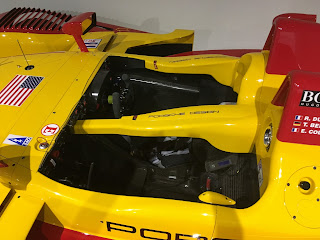2008 Porsche RS Spyder
While touring "The Porsche Effect" exhibit at the Petersen Automotive Museum several years ago, the author's first reaction upon seeing this car was that it is "a modern race car," until one realizes that it was ten years old and therefore historical.
In 2005, Porsche and their long-time partner, Penske Racing
entered into an agreement to race the Porsche-designed RS Spyder in the LMP2 (Le
Mans Prototype Class 2) class of the North American American LeMans Series
(ALMS). The Penske/Porsche RS Spyder competed for three full ALMS seasons – 2006,
2007, and 2008 - and dominated with 24 wins and nine championships.
The RS used a mid-engine longitudinally mounted carbon fiber
moncoque chassis with double wishbone torsion bar pushrod suspension anti-roll
bars and carbon fiber brakes at all four corners.
The RS powerplant, the Porsche MR6, engine was a 207 cubic inch 90 degree DOHC double overhead camshaft V-8 with four valves per cylinder that developed 478 horsepower. The power was fed through to the rear wheels via a six-speed sequential gearbox that like the engine was used as a stressed member.
The RS powerplant, the Porsche MR6, engine was a 207 cubic inch 90 degree DOHC double overhead camshaft V-8 with four valves per cylinder that developed 478 horsepower. The power was fed through to the rear wheels via a six-speed sequential gearbox that like the engine was used as a stressed member.
In the ten-race 2006 ALMS season, Penske Racing with their
twin Porsche RS Spyders sponsored by the international package handling service
DHL scored seven class wins and one overall win at the Mid-Ohio Sports Car
Course and claimed the LMP2 team and manufacturer championships. Sascha Maassen,
the German driver of the #6 RS Spyder won the driver’s championship with Lucas
Lohr, driver of Penske #7 RS Spyder the runner-up.
For the 2007 ALMS season all competitors raced with 10% E10
ethanol enrichment in their fuel tanks. The yellow and red DHL-sponsored Penske
Porsche RS Spyders dominated the series, as in twelve races, they scored eight
overall wins and three class wins. Penske repeated as the LMP2 team champion, Porsche
again won the Chassis Manufacturers' and Automobile Manufacturers' Championship
and Frenchman Romain Dumas won the drivers’ championship, as the Penske drivers
captured the first four positions.
For 2008, Porsche added direct fuel injection and the output
of the MR6 engine increased to 503 horsepower, although the ALMS required the LMP2
class cars to carry 55 pounds more weight than previous years.
This car shown at “the Porsche Effect” exhibit at the Petersen Automotive Museum won the 12 hours of Sebring overall to mark Porsche’s 18th overall win and first overall win at Sebring since 1988 on the 20th anniversary since its last win. The first three cars all finished on the same lap, as this car - chassis #802 - driven by German Timo Bernhard, Dumas and fellow Frenchman Emmanuel Collard finished with a winning margin of one minute and two seconds.
This car shown at “the Porsche Effect” exhibit at the Petersen Automotive Museum won the 12 hours of Sebring overall to mark Porsche’s 18th overall win and first overall win at Sebring since 1988 on the 20th anniversary since its last win. The first three cars all finished on the same lap, as this car - chassis #802 - driven by German Timo Bernhard, Dumas and fellow Frenchman Emmanuel Collard finished with a winning margin of one minute and two seconds.
The Penske team also claimed an overall 2008 victory at Miller
Motorsports Park, to go along with class wins at St. Petersburg Mid-Ohio and
Road Atlanta. Team Penske won the team LMP2 championship for the third consecutive
year, as did Porsche with the manufacturer championship as Bernhard and Dumas
shared the driver’s title.
With the announcement of the 2009 ALMS requirement of restrictor plates on the Porsche at the end of the 2008 season, Penske Racing Inc. withdrew from ALMS competition with a total of 24 class wins and eleven overall race wins. The car shown at the Petersen exhibit remains part of the Team Penske collection.
With the announcement of the 2009 ALMS requirement of restrictor plates on the Porsche at the end of the 2008 season, Penske Racing Inc. withdrew from ALMS competition with a total of 24 class wins and eleven overall race wins. The car shown at the Petersen exhibit remains part of the Team Penske collection.
All photographs by the author



No comments:
Post a Comment